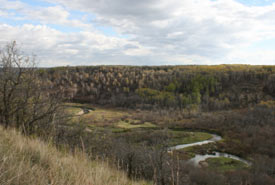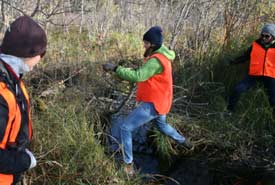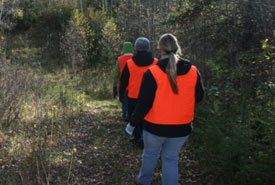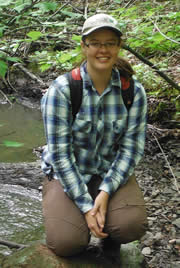Confessions of an NCC tour guide: Day Two

Fort Ellice, Riding Mountain (Photo by NCC)
With still lots of ground to cover we headed out bright an early for a hike through the Elk Glen. Our trail wound through a beautiful mixed wood forest, opening up into a beautiful, hilly fescue prairie. I diligently explained to Lisa and Christine how we collect data and pointed out all the rare and interesting plants; at least the ones that were still identifiable so late in the season.
Strangely they didn’t seem to share Julie and my excitement over some dead grass or the intricacies of entering species observation information in a geodatabase...So we quickly finished mapping the new occurrences and carried on.

Crossing the creek, Riding Mountain (Photo by NCC)
Our trail led us through the prairie into an oak forest along a south facing slope, then back down the north side into the spruce dominated mixedwoods again. As we wound our way back towards the fieldhouse, we followed along a number of wetlands and at one point right through one, but this time the beavers had come to our rescue by providing a nice little dam to cross on and keep our once again wader-less feet dry.
Back at the fieldhouse, we packed up, ate some of the Halloween chocolate bars that were my idea of a snack and headed out.
Continuing west, we headed for our Fort Ellice project, located in the East Parklands Natural Area near the Saskatchewan border. Located at the confluence of Beaver Creek and the Assiniboine River, Fort Ellice was once a hub of activity. While there may no longer be as many humans wandering about, wildlife abound in the diverse mosaic of habitats found on the property.
After pushing the tree off the trail blocking our access, we explored along Beaver Creek then up the valley wall, through mixed-grass prairie, aspen forest and oak savannah, and ending with a spectacular view of the river valley.

Hiking through a mixed wood forest (Photo by NCC)
Despite the urge to just sit and enjoy the view all day, the afternoon was waning, so we continued on to our final natural area and our final stop for the day. Our last visit was to a property in our Oak Lake Sandhills and Wetlands Natural Area. Hurrying to get to our destination and back before dark, we set out once again on a hike. This time we were climbing closed dunes in the Routledge Sandhills.
While the dunes are mostly closed (vegetated), patches of open sand (also called blowouts) still occur along steep slopes and areas of disturbance. These sandhills not only provide a breathtaking view, but they support a unique suite of species that have evolved to survive in the harsh sandy conditions, such as sand bluestem (yes another grass), tiger beetles and spinystar (a fat little cactus).
With the sun once again setting, we marched back to our vehicle and set off for civilization...With only one more hiccup when my attempt at a shortcut led to a water-covered road (much of this part of the province was under water due to extreme flood events during the summer). But after only a moment’s indecision, I decided it had a solid base and the water wasn’t that deep...and we got a free car wash out of the deal.
After an eventful (but not too eventful) trip we returned with some data for Julie and I, and official field experience for Christine and Lisa. However, the real success was the improved understanding of the individual roles that each of us play and how we can best work together to support each other in our daily work, and the reminder that although we are all doing very different things, we are all working towards achieving the same goal of protecting our very special natural landscapes.


